Introduction
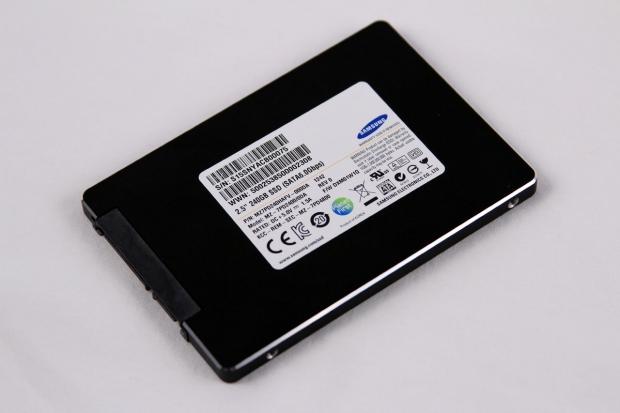
Samsung's SM843 Pro Data Center Series is the beginning of a deeper push from Samsung into the datacenter. The SM843 SATA SSD is geared for mainstream usage in a wide variety of typically read-centric workloads. The SM843 is the first new product in the Samsung datacenter SSD family, and following shortly will be Samsung's first SAS SSD, the SM1625. The SM1625 behemoth is designed for heavier workloads and features impressive specifications.
The SM843, in contrast, is intended for the entry-level and mainstream market. This segment is exploding rapidly and several key players have begun to address these markets with specialized solutions. Samsung is turning their attention to gaining more traction in this burgeoning market segment with the SM843, and intends to aggressively market this SSD at near-consumer pricing.
A key building block of the SM843 is Samsung's own 21nm MLC NAND. Samsung is the largest manufacturer of NAND in the world, controlling 42.7% of the market. Samsung's lead in the market is considerable, with the next two competitors combined equaling Samsung's market share. Much of Samsung's dominance in this market comes from lucrative contracts with Apple, the world's largest flash customer.
This tremendous manufacturing capacity provides Samsung with a formidable advantage, and including their own DRAM in their SSD takes this a step further. Manufacturing and implementing their own DRAM into the solution provides Samsung with additional flexibility in design and construction.
The final piece of the puzzle lies in the Samsung-powered MDX controller. Designed, engineered and manufactured by Samsung, the MDX controller is a powerful component that has fared well in a multitude of product variations in the consumer market. The successful 840 Series has highlighted the fact that the MDX controller is proven and reliable.
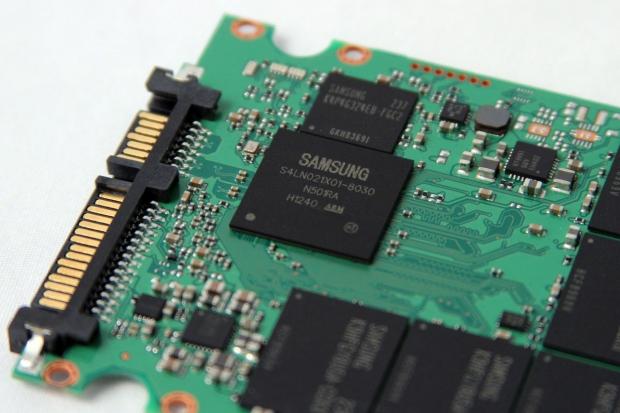
The 8-channel MDX controller sports three ARM Cortex R4 cores at 300MHz and delivers data via a 6Gb/s connection. This provides the SM843 with top sequential read and write speeds of 520MB/s -410MB/s, respectively. The random read IOPS are impressive, weighing in at a sustained 70,000 IOPS in steady state conditions.
The random write IOPS come in considerably lower, with a top speed of 11,500 IOPS. This disparity between the read and write speed illustrates the fact that this SSD is designed for light write workloads.
The SM843 also sports a rating of 1,080 random TBW (Terabytes Written) for the 480GB capacity version with standard MLC NAND. This is an impressive 1600% boost from the previous generation of Samsung's enterprise SSDs, which only offered 60TBW of endurance. While this is an impressive endurance increase percentage, it one should keep in mind that is only in relation to Samsung's previous products. Samsung also offers a rating for sequential workloads of up to 4,120 TBW.
Samsung's continuing foray into the enterprise space comes in the midst of heavy market segmentation. Other smaller SSD manufacturers, and large foundry competitors such as Intel and Micron, are also offering value parts that offer impressive endurance specifications in conjunction with solid performance. The budget-conscious market can be brutal, but with Samsung's manufacturing capabilities, and fully vertically-integrated SSD, they feel they can provide a compelling solution to their customers.
Samsung SM843 Specifications
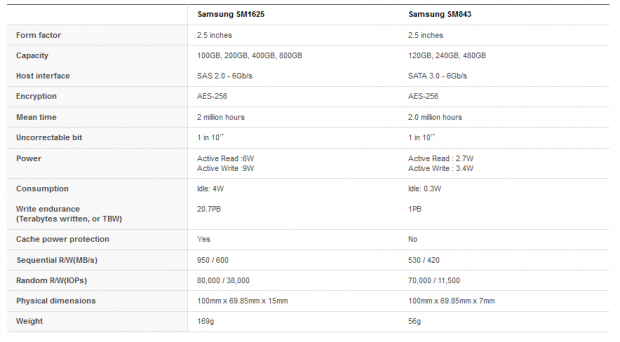
The SM843 will come in capacities of 120GB, 240GB and 480GB. The available capacity of these SSDs is only slightly lower than their consumer market counterparts, and reflects the extra overprovisioning provided for enterprise workloads.
The MDX controller wrings extra endurance from the 20nm MLC NAND utilized with the SM843 via numerous techniques. Standard ECC is backed by DSP and adaptive flash programming techniques.
The SSD comes in the standard 2.5' form factor with a 7mm Z-Height. This will allow deployment of the SSD into slim applications.
The SM843 has a low active read power consumption of 2.7 Watts, and an active write consumption of 3.4 Watts, which we will put to the test with our power testing later in the review. The low power threshold and the high read IOPS provide an SSD that Samsung feels will offer an impressive IOPS-to-Watts solution.
The SM843 features standard AES-256 encryption, and does not include any type of power fail protection.
The specifications below also feature the forthcoming SAS SSD from Samsung. This will be utilized in high-write environments and features a more robust feature set.
Samsung SM843 Internals
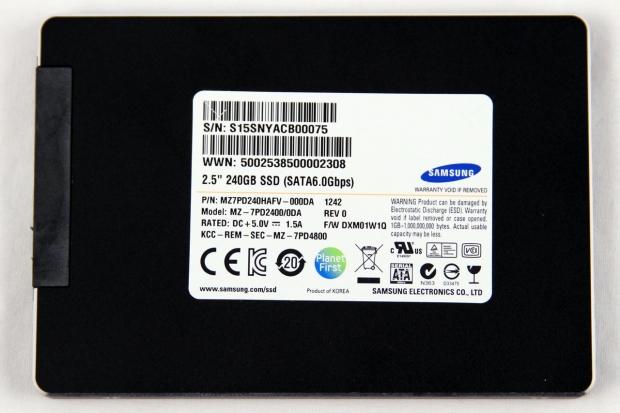
The exterior of the SM843 features a nice bevel and relevant product information on the sticker. The Samsung SM843 comes in the 2.5-inch form factor with a 7mm Z-Height. This enables deployment into slim applications and blade servers.
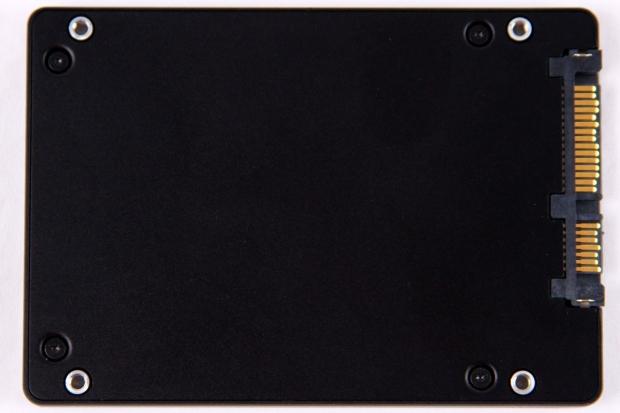
The rear of the SSD is unremarkable, though we do note the pentalobular screws that Samsung uses for all of its SSDs. The exterior is the exact same as the consumer 840 Series SSDs.
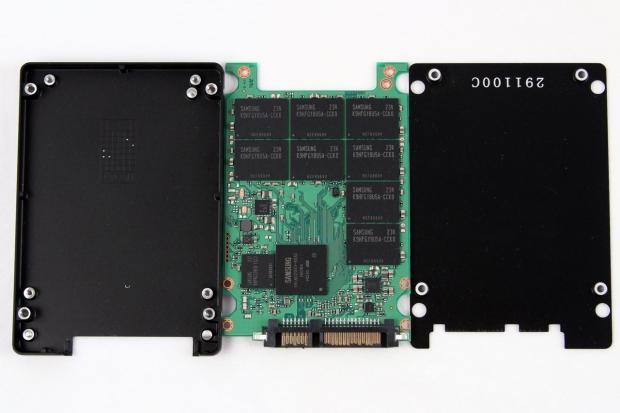
The SM843 does not employ the use of thermal pads, and the case of the SSD consists of a thin metal shell.
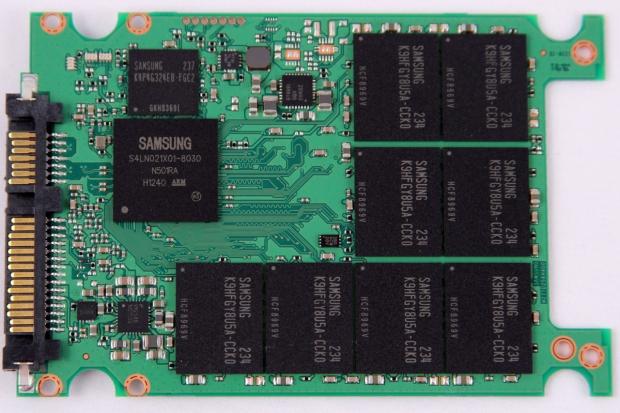
The MDX controller is an eight-channel three core (ARM R4 Cortex) controller. The hardware, controller, NAND and DRAM are all the same as the hardware employed in the standard consumer 840 series. The only difference is the firmware and extra overprovisioning over the standard 7% employed in the 840 Series SSDs (8GB extra for the model we are testing). There are eight emplacements of 20nm Samsung MLC NAND.
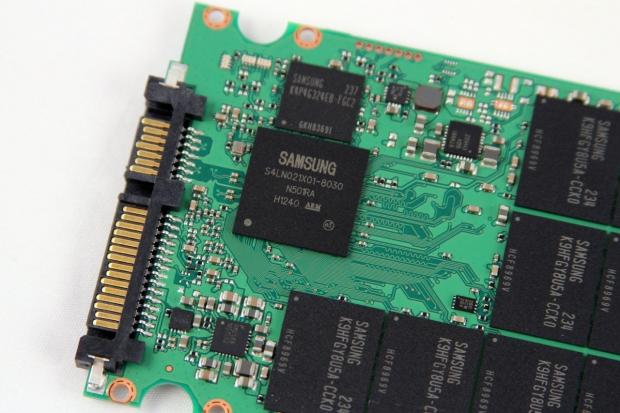
Directly above the MDX controller we can observe the 512MB of LPDDR2-1033 RAM cache. We also note the distinct lack of power holdup circuitry.
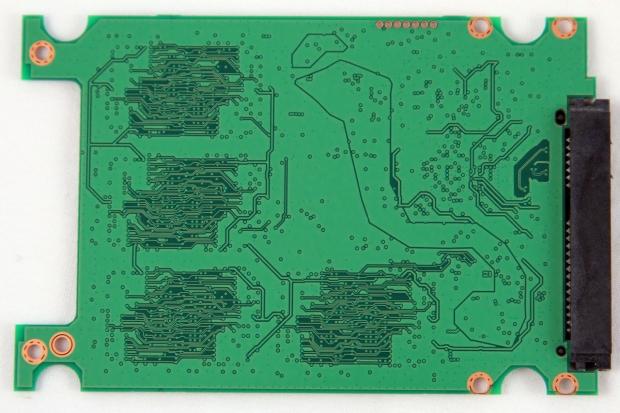
The rear of the SSD is devoid of any components.
Test System and Methodology

We utilize a new approach to HDD and SSD storage testing for our Enterprise Test Bench, designed specifically to target the long-term performance of solid state with a high level of granularity.
Many forms of testing involve utilizing peak and average measurements over a given time period. While these average values can give a basic understanding of the performance of the storage solution, they fall short in providing the clearest view possible of the QOS (Quality Of Service) of the I/O.
'Average' results do little to indicate the performance variability experienced during the actual deployment of the device. The degree of variability is especially pertinent, as many applications can hang or lag as they wait for one I/O to complete. This type of testing illustrates the performance variability expected in these types of scenarios, including the average measurements, during the measurement window.
In reality, while under load all storage solutions deliver variable levels of performance that are subject to constant change. While this fluctuation is normal, the degree of fluctuation is what separates enterprise storage solutions from typical client-side hardware. By providing ongoing measurements from our workloads with one-second reporting intervals, we can illustrate the difference between different products in relation to the purity of the QOS. By utilizing scatter charts readers can gain a basic understanding of the latency distribution of the I/O stream without directly observing numerous graphs.
Consistent latency is the goal of every storage solution, and measurements such as Maximum Latency only illuminate the single longest I/O received during testing. This can be misleading, as a single 'outlying I/O' can skew the view of an otherwise superb solution. Standard Deviation measurements take the average distribution of the I/O into consideration, but do not always effectively illustrate the entire I/O distribution with enough granularity to provide a clear picture of system performance. We use histograms to illuminate the latency of every single I/O issued during our test runs.
Our testing regimen follows SNIA principles to ensure consistent, repeatable testing. We attain steady state convergence through a process that brings the device within a performance level that does not range more than 20% from the average speed measured during the measurement window. Forcing the device to perform a read-write-modify procedure for new I/O triggers all garbage collection and housekeeping algorithms, highlighting the real performance of the solution.
We only test below QD32 to illustrate the scaling of the device. However, low QD testing with enterprise-class storage solutions is a frivolous activity if not presented with higher QD results as well. The explosion of virtualization into the datacenter places focus on the high QD performance of the storage solution as the most important metric.
We have also begun expanded power testing with a measurement of the power consumption during each of our precondition runs. This provides measurements in time-based fashion, measured every second, that illuminate the behavior of the power consumption in steady state conditions. The power consumption of storage devices can cost more over the life of the device than the actual up-front costs of the drive itself. This significantly affects the TCO of the storage solution.
The first page of results will provide the 'key' to understanding and interpreting our new test methodology.
4K Random Read/Write
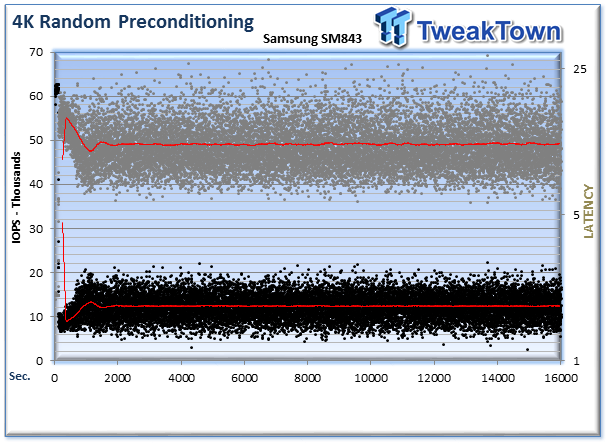
We precondition the Samsung SM843 for 18,000 seconds, or five hours. Every second we are receiving reports on several parameters of the workload performance. We then plot this data to illustrate the drives' descent into steady state.
This chart consists of 36,000 data points. The black dots signify the IOPS during the test, and the light brown dots are the latency encountered during the test period. We place the latency data in a logarithmic scale to bring it into comparison range. This is a dual-axis chart with the IOPS on the left and the latency on the right. The lines through the data scatter are the average during the test. This type of testing presents standard deviation and maximum/minimum I/O in a visual manner.
Note that the IOPS and Latency figures are nearly mirror images of each other. This illustrates the point that high-granularity testing can give our readers a good feel for the latency distribution by viewing IOPS at one-second intervals. This should be in mind when viewing our test results below.
We provide histograms to provide further latency granularity below. This preconditioning slope of performance happens very few times in the lifetime of the device, and we present these test results for the tested device only to confirm the attainment of steady state convergence.
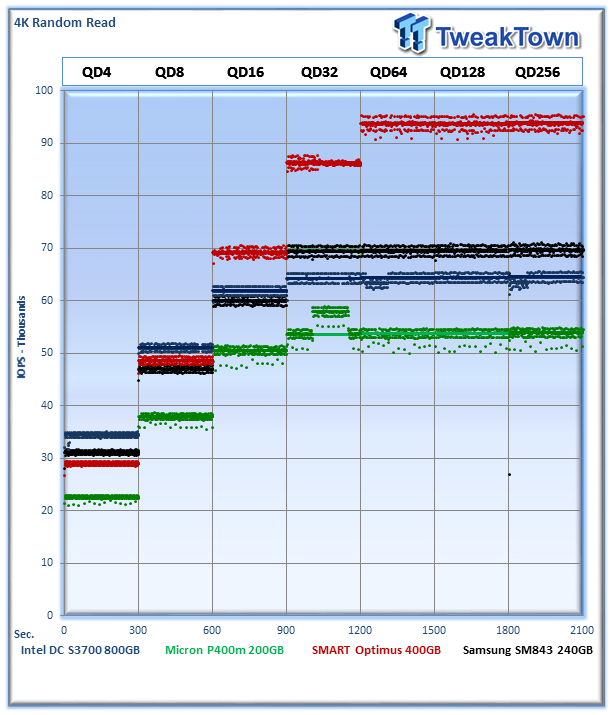
Each QD for every parameter tested includes 300 data points (five minutes of one second reports) to illustrate the degree of performance variability. The line for each QD represents the average speed reported during the five-minute interval.
4K random speed measurements are an important metric when comparing drive performance, as the hardest type of file access for any storage solution to master is small-file random. One of the most sought-after performance specifications, 4K random performance is a heavily marketed figure.
The SM843 averages an impressive 69,654 IOPS in random 4K read speed at QD256. This is higher than all other SATA SSDs, except the SMART Optimus. The Micron P400m averages 53,847 IOPS, the Intel DC S3700 64,533 IOPS, and the SMART Optimus 93,860 IOPS.
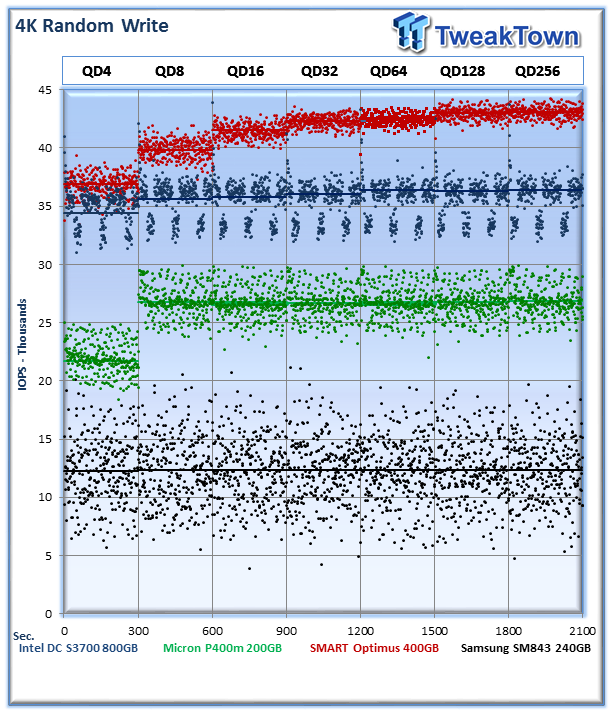
Garbage collection routines are more pronounced in heavy write workloads. The Samsung SM843 averages 12,313 IOPS in 4k write at QD256. This is well below all of the competing solutions. The Micron P400m averages 26,815 IOPS, the Intel DC S3700 36,428 IOPS, and the SMART Optimus 43,081 IOPS.
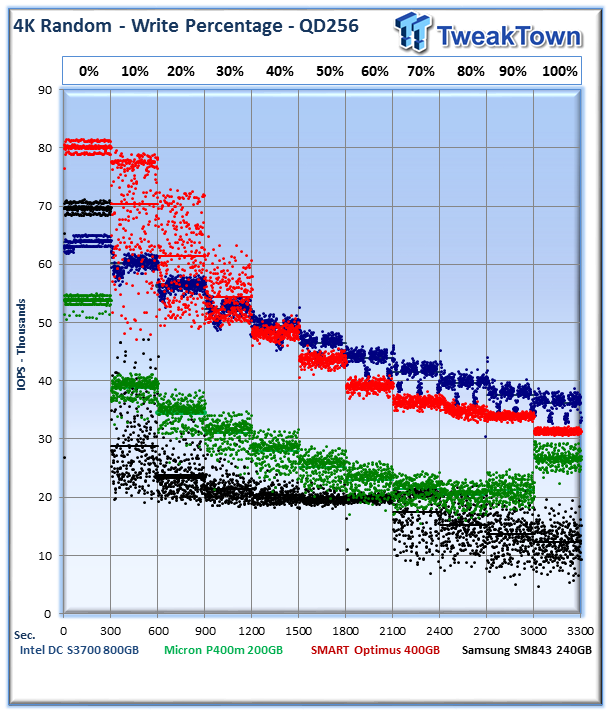
Our write percentage testing illustrates the varying performance of each solution with mixed workloads. The 0% column to the left is a pure read of the 4K file size, and as the charts progresses to the right we illustrate a pure 4K write workload.
The Intel and SMART Optimus perform very well with this test, and the Micron and SM843 come in at the bottom of the chart. The SM843 provides steady performance from the 10% to 60% range, but then falls to an average of 13,000 IOPS at a 100% 4k write workload.
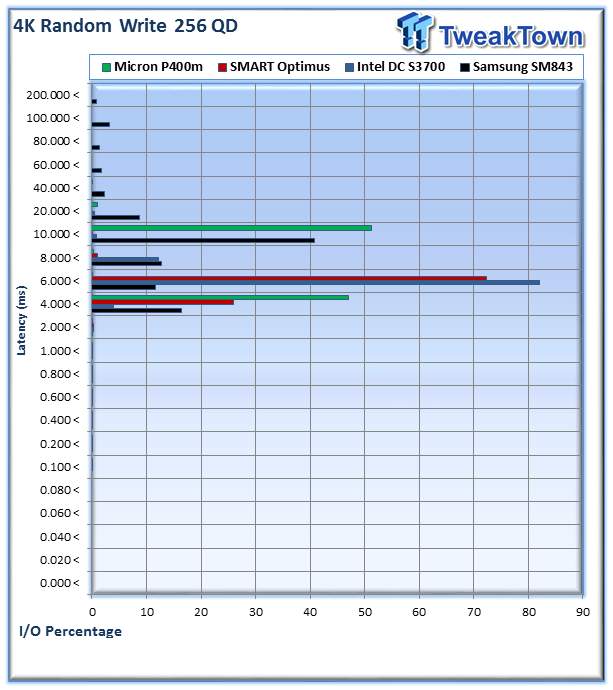
The SM843 exhibits a wide range of latency during the measurement window. There are sporadic bursts of latency that are far above the other SSDs tested. Overall, the SM843 does not demonstrate a very tight latency range in this test. 40% of I/O was served in the 10-20ms range, 16% in 4-6ms, 12% in 8-10ms, 11% in 6-8ms, and then an entire smattering of ranges that peaks at 200ms.
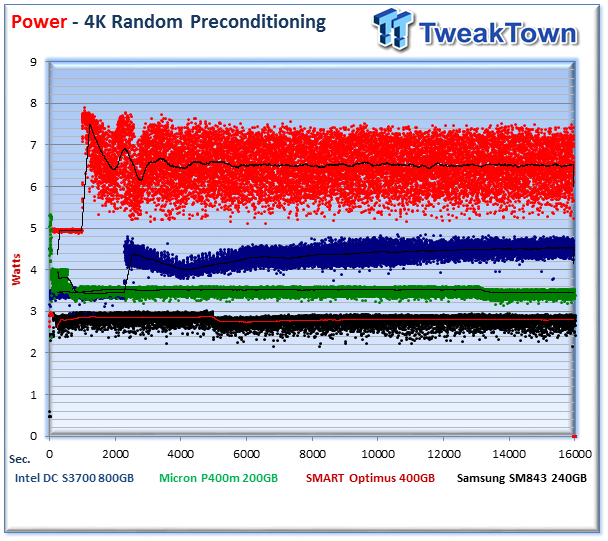
The power consumption measurements, taken during our precondition run, for the Samsung SM843 are very good. The SM843 averages 2.79 Watts, the lowest among the tested devices. The Micron 3.5 Watts, in comparison to the Intel at 4.36 Watts and the SMART Optimus at 6.51 Watts.
The SM843 provides 4,407 write IOPS per Watt. The P400m 7,624 IOPS, the Intel 8,336 IOPS, and the Optimus 6,617 IOPS.
8K Random Read/Write
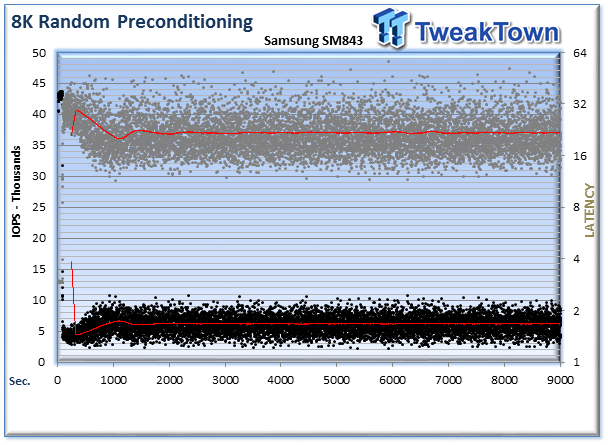
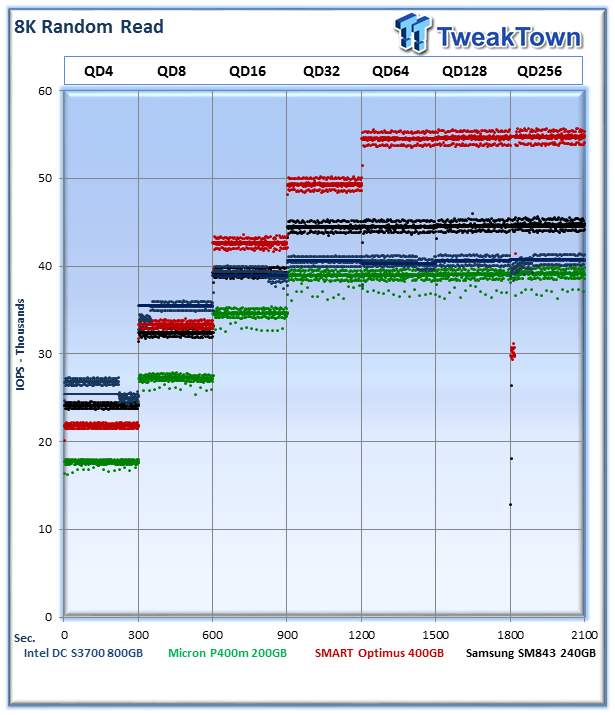
8K random read and write speed is a metric that is not tested for consumer use, but for enterprise environments this is an important aspect of performance. With several different workloads relying heavily upon 8K performance, we include this as a standard with each evaluation. Many of our Server Emulations below will also test 8K performance with various mixed read/write workloads.
The average 8K random read speed of the SM843 was 44,499 IOPS during the QD256 measurement window. The P400m at QD256 was 39,122 IOPS, the DC S3700 was 40,766 IOPS compared to 54,767 IOPS for the Optimus.
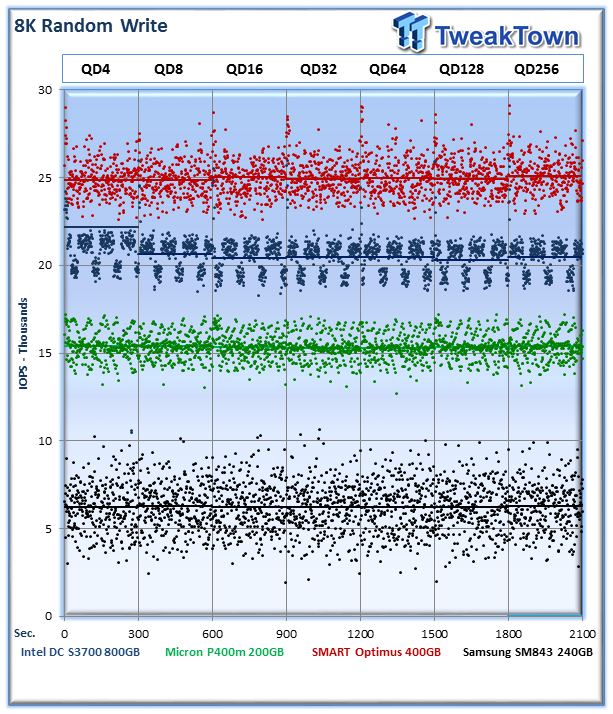
The average 8K random write speed of the Samsung SM843 was 6,269 IOPS, again trailing the pack. This workload also exhibited a wide range of I/O rates during the test. The Micron P400m at QD256 was 15,394 IOPS, the DC S3700 was 20,475 IOPS and the Optimus delivered 25,096 IOPS.
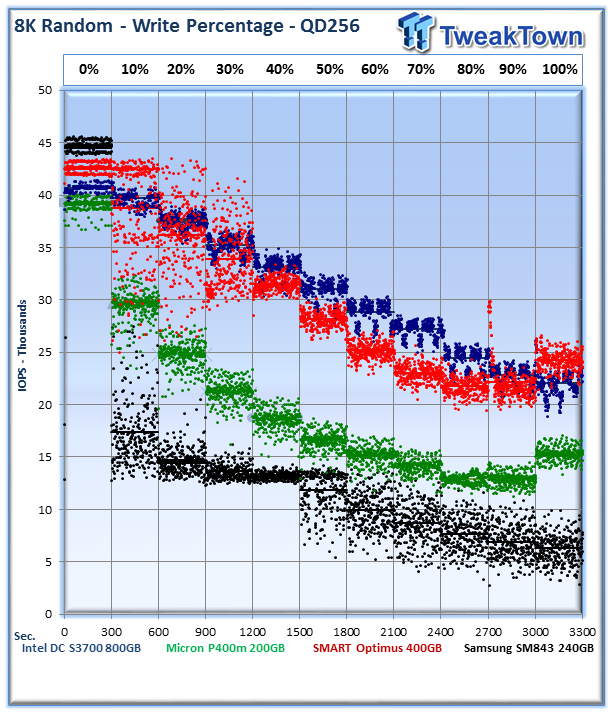
The SM843 leads the pack with the pure 8K random read speed, but quickly falls to the bottom once we begin mixing in a write workload. When under heavier write loads the SM843 begins to exhibit much more variability in performance.
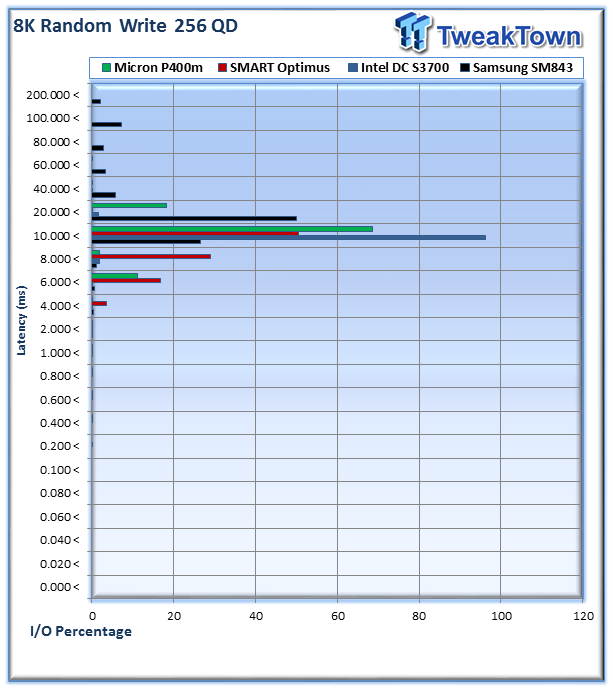
The Samsung SM843 again demonstrates a wide range of latency variability during the test, with 50% of I/O at 20-40ms, 26% at 10-20ms, and a wide range of distribution in the other areas, topping out at 200ms.
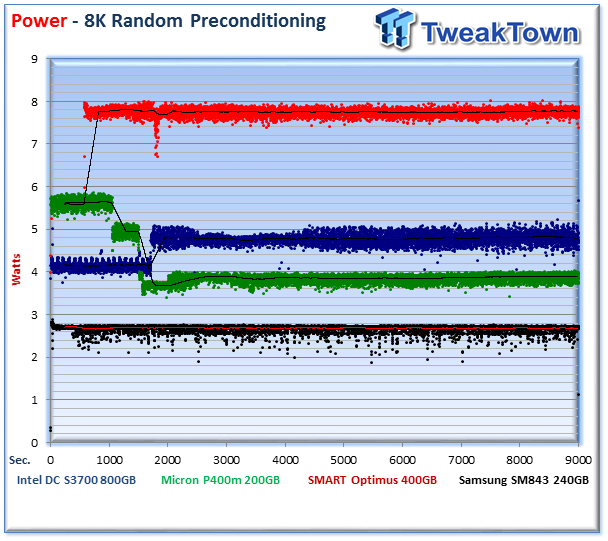
The power for the SM843 averaged 2.67 Watts during the test, the Micron P400m 3.89 Watts, the Intel 4.81 Watts, and the Optimus 7.7 Watts.
The SM832 weighs in at 2,340 write IOPS per Watt, the Micron 3,954 IOPS, the Intel 4,252 IOPS and the Optimus 3,228 IOPS.
128K Sequential Read/Write
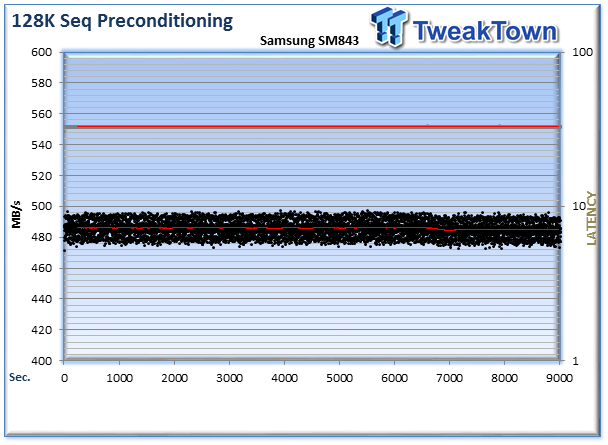
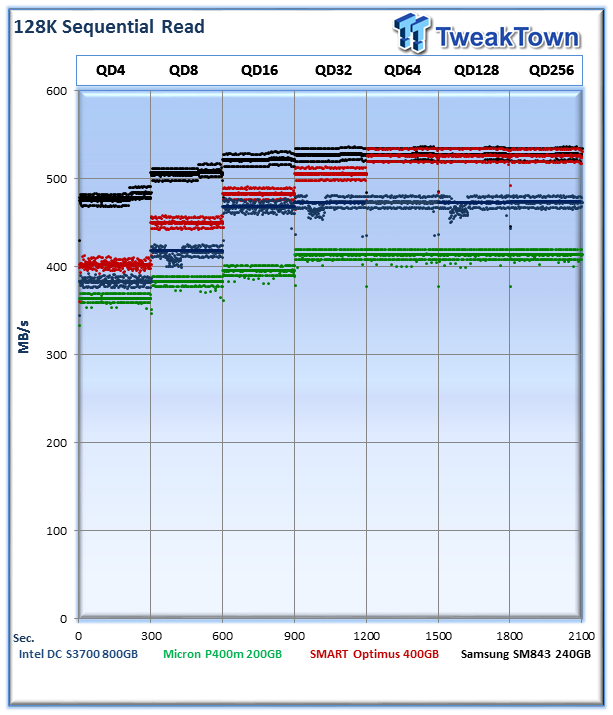
The 128K sequential speeds reflect the maximum sequential throughput of the SSD using a realistic file size actually encountered in an enterprise scenario.
The SM843 performs very well with pure sequential workloads, scoring an average of 527MB/s at QD256. This tremendous read speed actually matches the SAS-powered Optimus. The Micron averaged 413MB/s in sequential reads at QD256, the Intel DC S3700 473MB/s, and the Optimus 526MB/s.
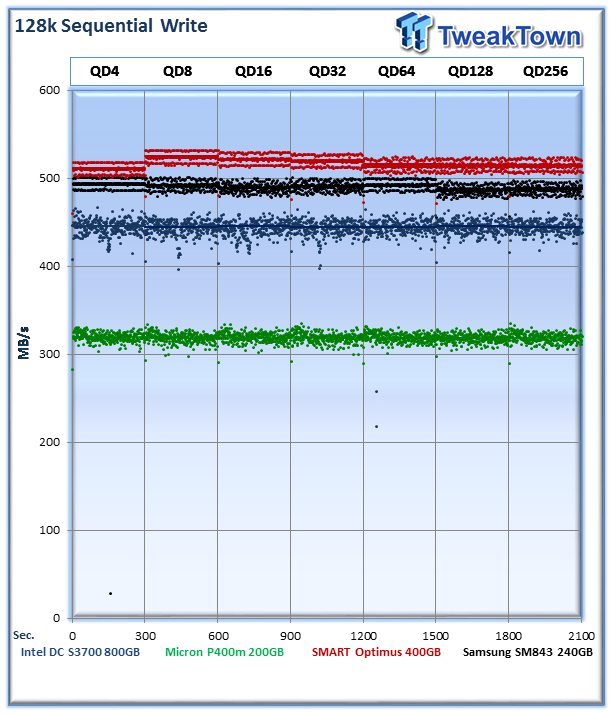
The SM846 averages an impressive 487MB/s in sequential write speed at QD256. The Micron P400m averages 318MB/s, the DC S3700 444MB/s, and the Optimus weighs in at 514MB/s.
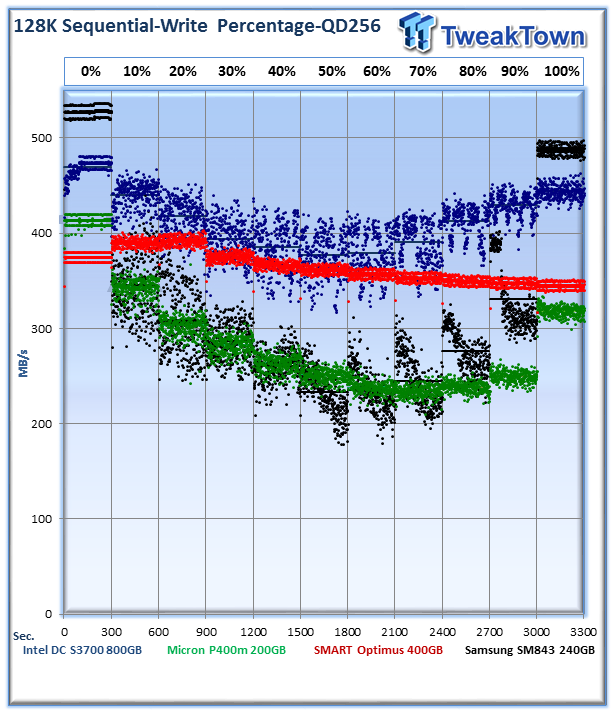
The SM843 performs very well at both ends of the extreme. With pure sequential read and write workloads the MDX controller provides a clear advantage. Adding in mixed workloads does lead to a slump in performance.
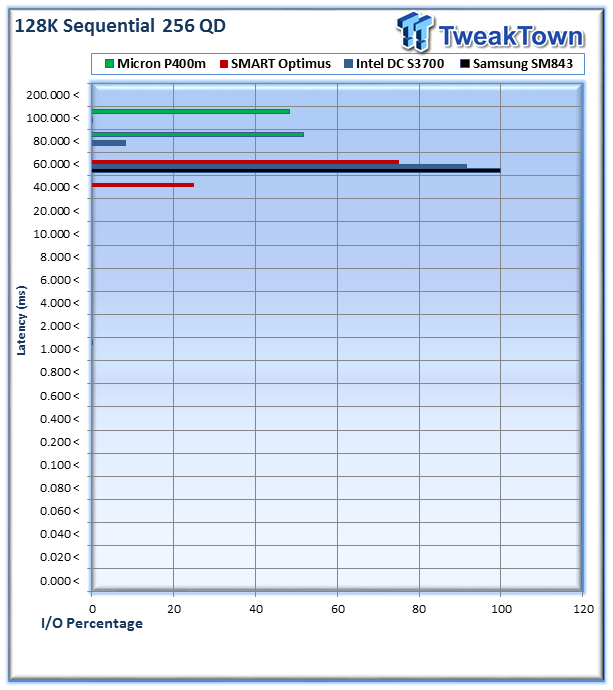
The SM843 delivers excellent latency with a 128K sequential write workload, delivering 100% of I/O in the 60-80ms range. The SM843 really comes into its own with sequential workloads.
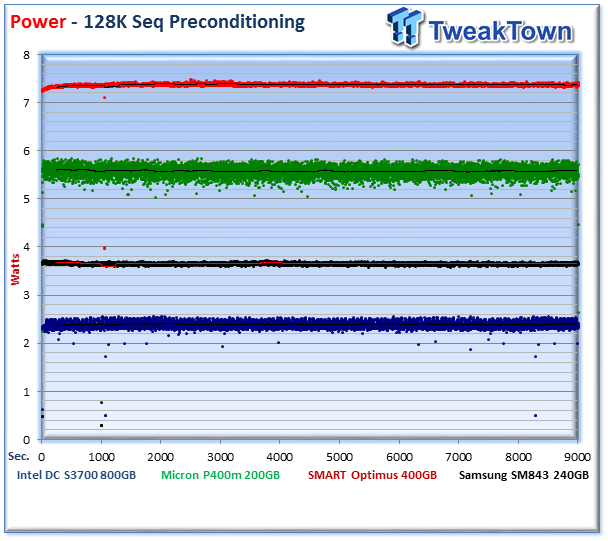
The SM843 averages 3.65 Watts at a QD256 sequential write workload, the Micron P400m 5.57 Watts, the Intel 2.39 Watts, and the Optimus 7.37 Watts.
The SM843 provides 133 MB/s write IOPS per Watt, the P400M 57MB/s IOPS, the DC S3700 185MB/s and the Optimus 69MB/s.
OLTP and Webserver
OLTP
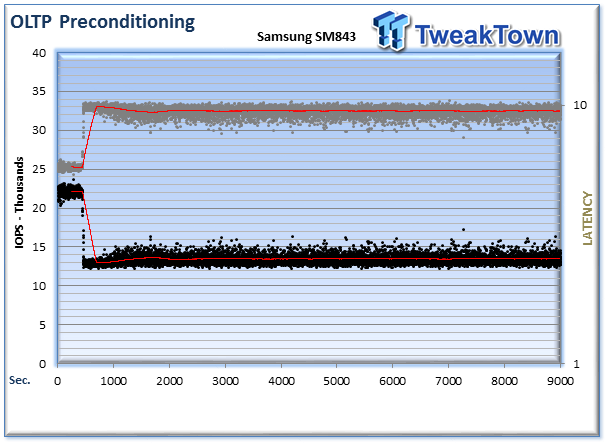
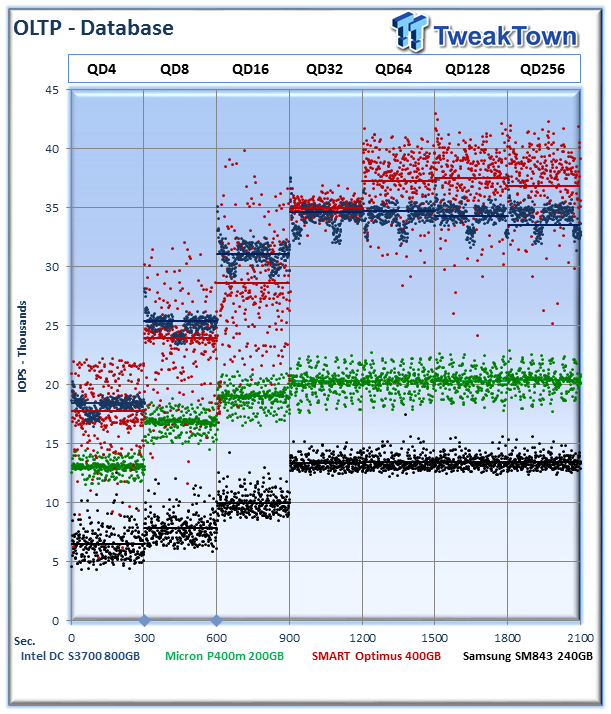
This test emulates Database and On-Line Transaction Processing (OLTP) workloads. OLTP is in essence the processing of transactions such as credit cards and high frequency trading in the financial sector. Enterprise SSDs are uniquely well suited for the financial sector with their low latency and high random workload performance. Databases are the bread and butter of many enterprise deployments. These are demanding 8K random workloads with a 66% read and 33% write distribution that can bring even the highest performing solutions down to earth.
The SM843 averages 13,481 IOPS at QD256, the P400m 20,413 IOPS, the DC S3700 33,546 IOPS, and the Optimus 36,837 IOPS.
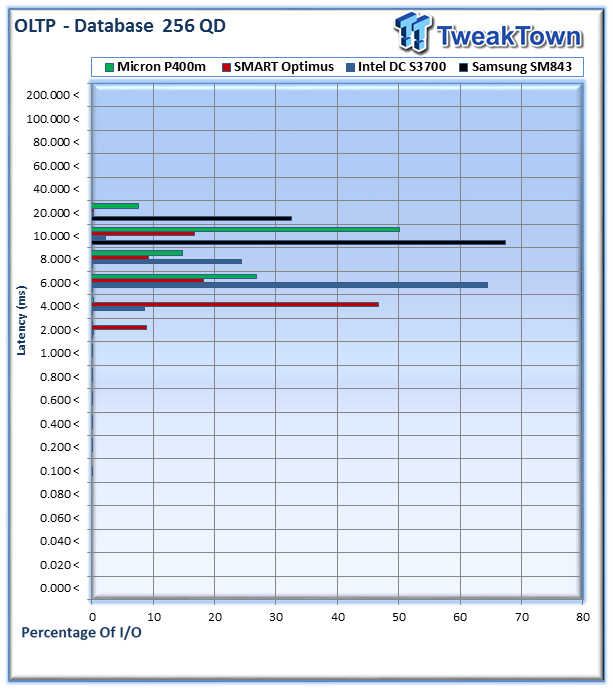
The SM843 provides a tighter range of performance in this test, with 67% of I/O in the 10-20ms range and 32% in the 20-40ms range.
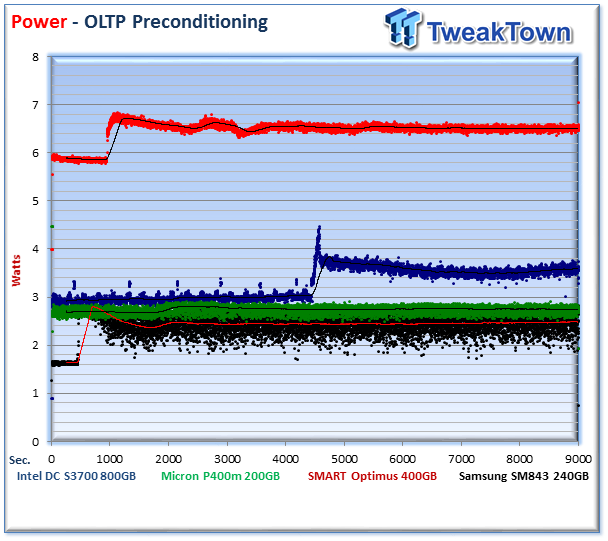
The SM843 averages 2.47 Watts, the P400m 2.75 Watts, the Intel 3.56 Watts and the Optimus 6.5 Watts.
This gives the SM843 5,448 write IOPS per Watt, the Micron P400m 7,422 IOPS per Watt, the Intel 9,418 IOPS per Watt, and the Optimus 5,659 IOPS per Watt.
Webserver
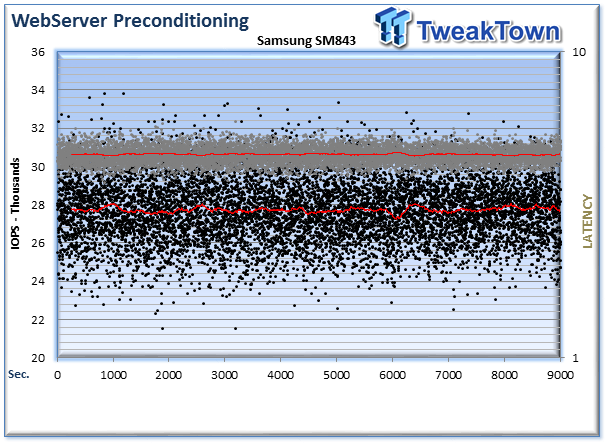
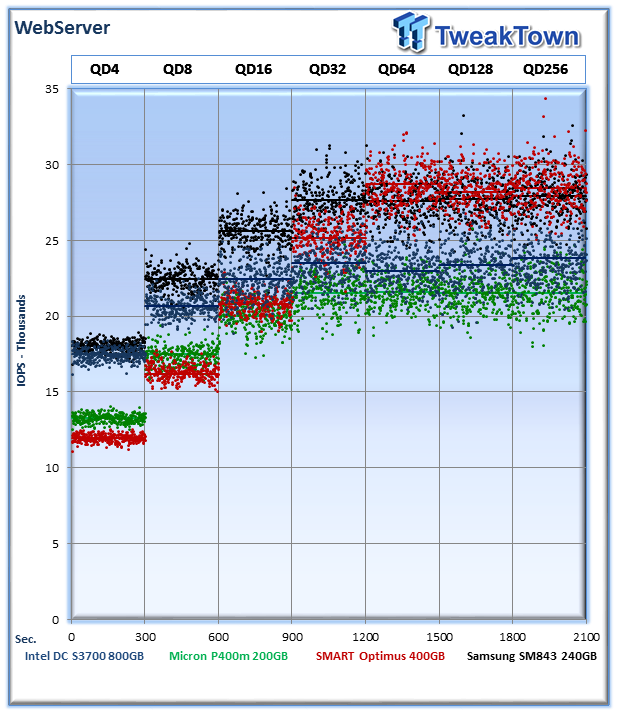
The Webserver profile is a read-only test with a wide range of file sizes. Web servers are responsible for generating content for users to view over the internet, much like the very page you are reading. The speed of the underlying storage system has a massive impact on the speed and responsiveness of the server that is hosting the websites, and thus the end user experience.
The SM843 averages 27,919 IOPS at QD256, the P400m 21,533 IOPS, the Intel 33,546 IOPS, and the Optimus 36,837 IOPS. All SSDs exhibit some variance, but taking into consideration the scale of the graph it is minimal.
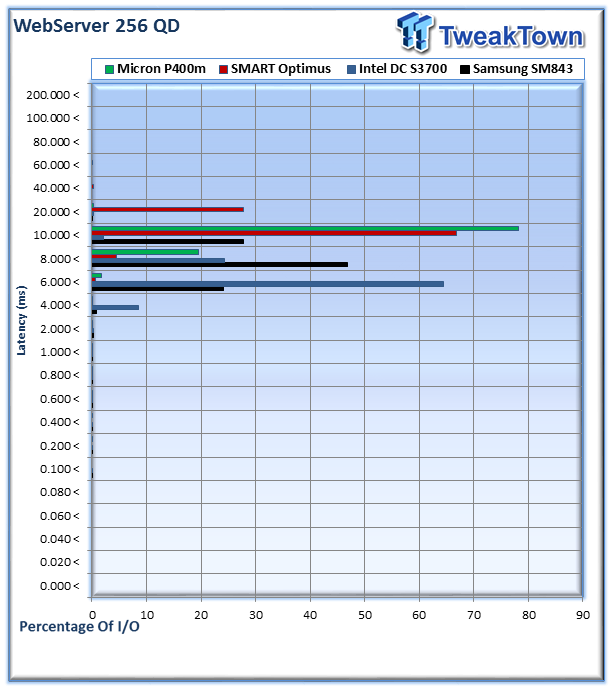
The SM843 delivers 46% of I/O in the 8-10ms range, 27% in 10-20ms, and 24% in 6-8ms.

The SM843 averages 2.06 Watts, the Micron P400m 2.59 Watts, the Intel 2.24 Watts, and the Optimus 5.61 Watts.
This gives the SM843 13,542 IOPS per Watt, the P400m 8,304 IOPS, the Intel 10,600 IOPS, and the Optimus 5,071 IOPS.
Fileserver and Emailserver
Fileserver
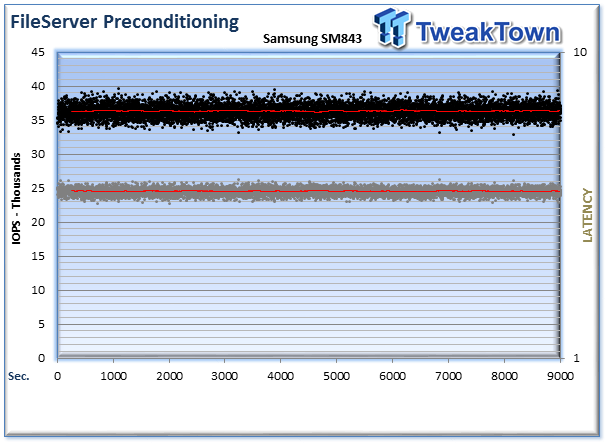
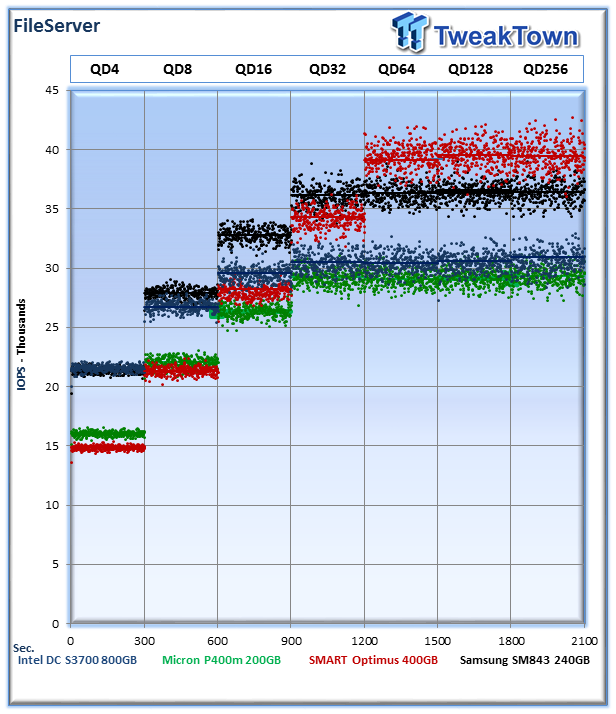
The File Server profile represents typical file server workloads. This profile tests a wide variety of different file sizes simultaneously, with an 80% read and 20% write distribution.
The SM843 averages 36,413 IOPS at QD256, very close to the Optimus; the P400m 29,311 IOPS, the DC S3700 30,888 IOPS, and the Optimus 39,434 IOPS.
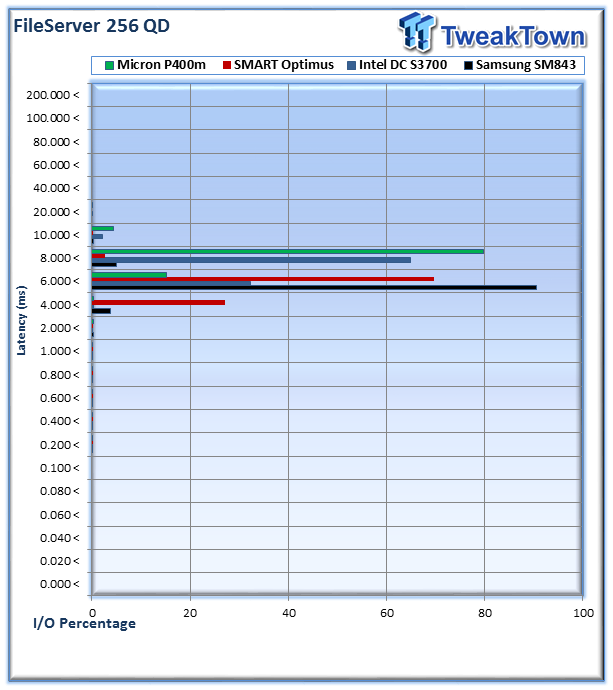
The SM843 gives an excellent showing in this test, with 90% of I/O coming in at 6-8ms.
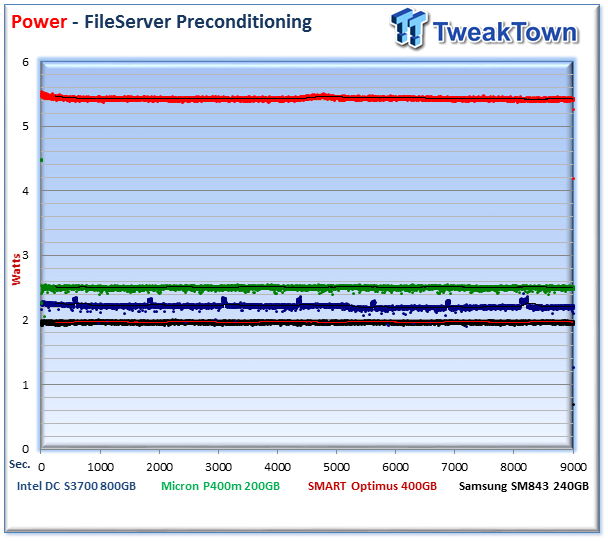
The SM843 averages 1.96 Watts, the P400m averages 2.76 Watts, the Intel averages 2.2 Watts, and the Optimus averages 5.41 Watts.
The SM843 gives 18,507 IOPS per Watt, the P400m 10,593 IOPS, the Intel 14,040 IOPS, and the Optimus weighs in at 7,276 IOPS per Watt.
Emailserver
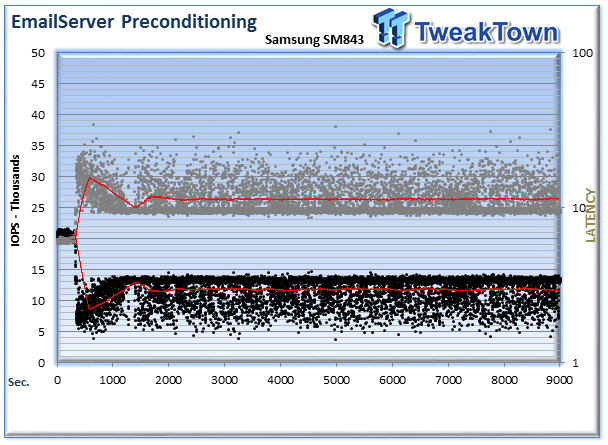
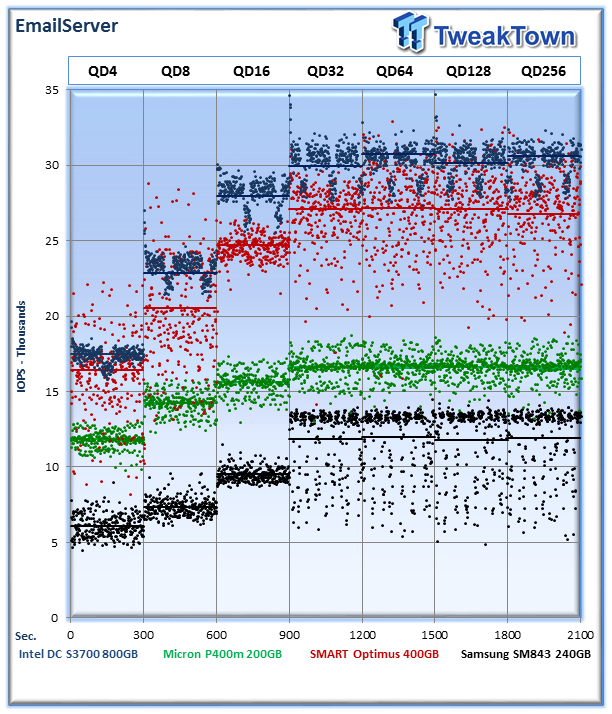
The Emailserver profile is very demanding 8K test with a 50% read and 50% write distribution. This application is indicative of the performance of the solution in heavy write workloads.
The SM843 unsurprisingly falls into some wide latency variances with this heavy write workload. The SM843 averages 11,911 IOPS at QD356, the Micron 16,609 IOPS, the Intel 30,632 IOPS, and the Optimus averages 26,762 IOPS.
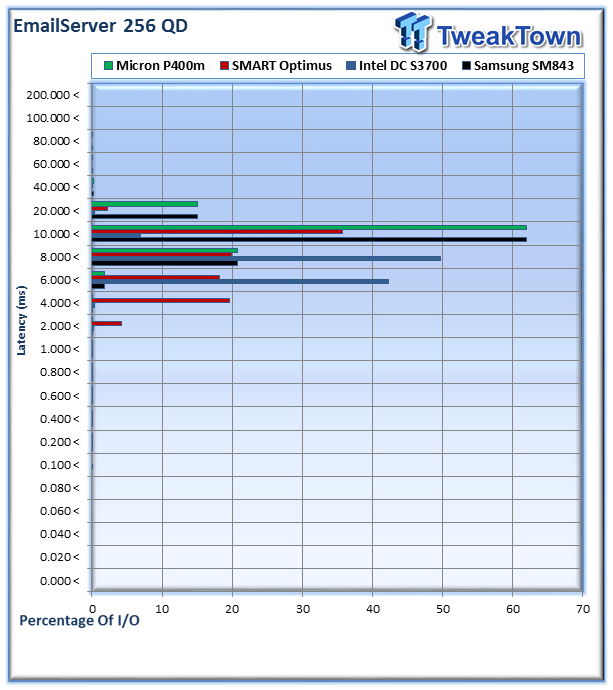
The SM843 has a very wide distribution of latency in the workload; this is evidently not an intended workload for the SM843 with the heavy write percentage. 62% of I/O falls into the 10-20ms range, 20% in 8-10ms, and 15% in 20-40ms, followed by a wide range topping out at 80-100ms.
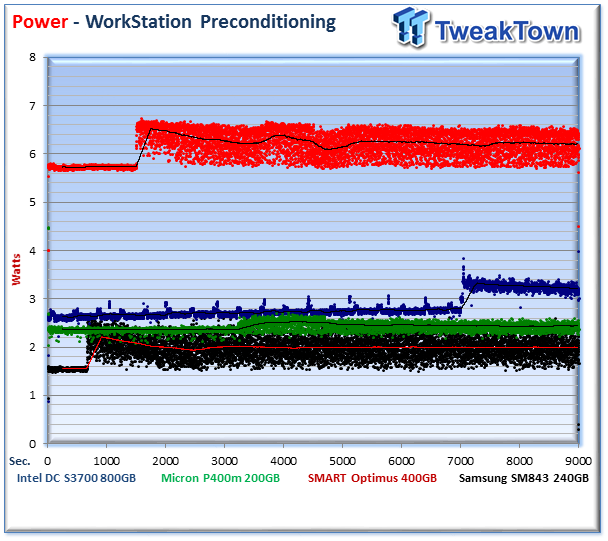
The SM843 averages 2.69 Watts at QD256, the P400m 2.74 Watts, the Intel DC S3700 4.12 Watts, and the Optimus averaged 6.58 Watts. This averages out to 4,421 IOPS per Watt for the SM843, 6,041 IOPS for the Micron P400m, 7,425 IOPS for the Intel, and 4,066 IOPS per Watt for the Optimus.
Final Thoughts
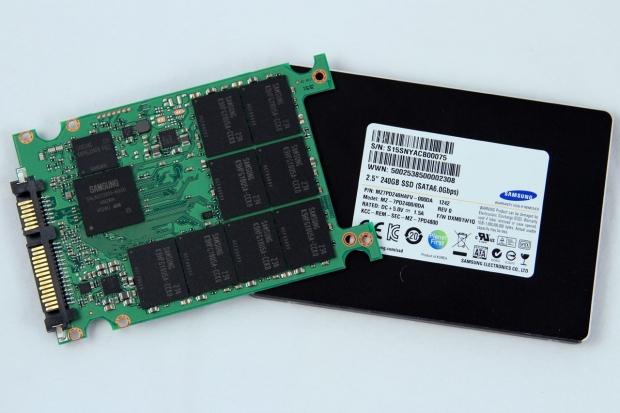
Samsung's first wave of attack into the enterprise comes in the form of the SM843 we tested today. To understand the genius in the performance of the SM843 we must fully understand the intended market for this SSD.
It is important to keep these test results in perspective and note that this is a varied test pool of SSDs. We have a high-end SAS SSD, two mainstream usage SATA SSDS, and the SM843, which falls into the moderate-usage model for SSDs. Bear in mind that the price structure of the SM843 is significantly lower than the competing drives, and provides a performance vs. price advantage in moderate workload and read-centric applications. In most scenarios, these SSDs would not compete directly, and the SM843's solid performance in comparison to higher priced alternatives leads to our choice of awarding this SSD with the Performance Award.
Surprisingly, the main competition for the SM843 will be with consumer SSDs. We are witnessing heavy implementation of consumer SSDs into datacenter applications. The large price advantages to these rip-and-replace deployments is very enticing for some, but many times can end in high failure rates and data loss.
Competing in the value market can be brutal, and Samsung does have some distinct advantages in this respect. The ability to provide a solution built from scratch in their own facilities delivers an advantage in pricing margins, and delivering this SSD at near-consumer price levels will help Samsung move large quantities of units.
Samsung's SM846 forgoes expensive features commonly observed in enterprise class SSDs. The notable lack of power fail protection is not necessary when competing with consumer SSDs and the exclusion of this feature will help Samsung compete aggressively with pricing.
The SM843 features massive similarities to Samsung's consumer hardware, but has its own firmware revision. Details are scant into any advantages that this firmware would hold for data protection over consumer products.
The SM843 performed well in our power testing with an overall low power consumption threshold. The write speeds that we observed during our testing were among the lowest in the test filed. These low write speeds could significantly increase with the inclusion of more overprovisioning.
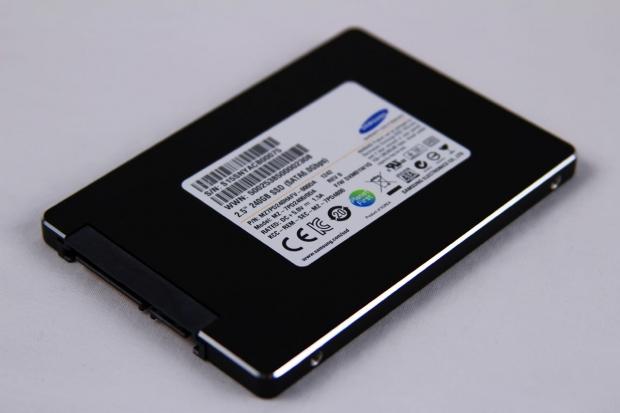
One area that we feel that Samsung can also improve is the TBW rating of the SSD. There are many solutions available from a variety of vendors that offer budget-conscious SSDs with higher endurance specifications. The SM843 features a relatively small amount of overprovisioning compared to the competition, and this shows up in the endurance specifications.
The answer to the relatively low endurance (in comparison to other products) and lackluster write speed can be addressed through pricing. Keeping a low price threshold will provide enough cost savings per gigabyte to allow users to manually implement extra overprovisioning to help address performance concerns. This does blur the cost advantage of utilizing a low price solution, but provides users with the ability to scale the overprovisioning with their intended workload.
The Samsung SM843 is a solid performer, with the exception of scattered latency with small file random access. It performs particularly well with sequential workloads, but does lack some of the luster of other full featured products. While the increase in endurance compared to previous Samsung SSDs is impressive, there are other large players, and other upstarts, offering better endurance characteristics.
The SM843 seems destined to compete with consumer SSDs pressed into service in datacenter environments. The success of this product will be driven by Samsung's ability to leverage their 'foundry advantage' and deliver cutthroat pricing.

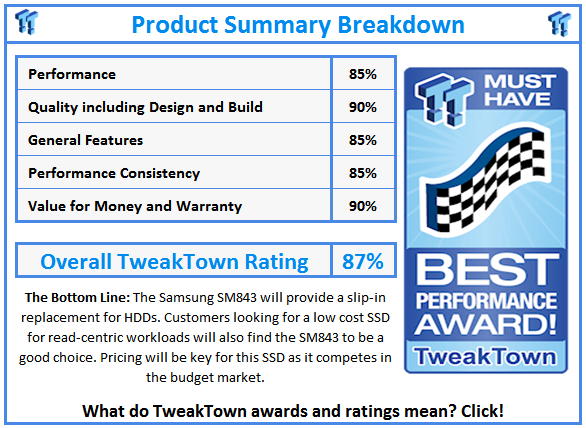
 United
States: Find other tech and computer products like this
over at
United
States: Find other tech and computer products like this
over at  United
Kingdom: Find other tech and computer products like this
over at
United
Kingdom: Find other tech and computer products like this
over at  Australia:
Find other tech and computer products like this over at
Australia:
Find other tech and computer products like this over at  Canada:
Find other tech and computer products like this over at
Canada:
Find other tech and computer products like this over at  Deutschland:
Finde andere Technik- und Computerprodukte wie dieses auf
Deutschland:
Finde andere Technik- und Computerprodukte wie dieses auf